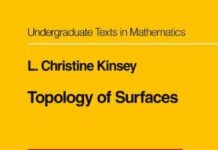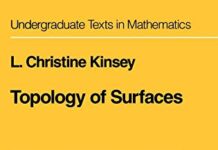
Ebook Info
- Published: 2008
- Number of pages: 494 pages
- Format: PDF
- File Size: 6.89 MB
- Authors: L. Christine Kinsey
Description
Symmetry, Shape, and Space uses the visual nature of geometry to involve students in discovering mathematics. The text allows students to study and analyze patterns for themselves, which in turn teaches creativity, as well as analytical and visualization skills. Varied content, activities, and examples lead students into an investigative process and provide the experience of doing and discovering mathematics as mathematicians do. Exercises requiring students to express their ideas in writing and to create drawings or physical models make math a hands-on experience. Assuming no mathematics beyond the high school level, Symmetry, Shape, and Space is the perfect introduction to mathematics in the liberal arts course of study, and it is designed so that each chapter is independent of the others, allowing great flexibility.
User’s Reviews
Editorial Reviews: Review From the reviews: “The text is written in an accessible and chatty style … . There is, however, a very conscious effort to engage the reader in active exploration and discovery, and so every topic is introduced as a practical exercise involving equipment which is readily available in every classroom, and the text is peppered with problems and questions for investigation. … There are so many good things covered in the text that it is hard to pick out one or two.” (Gerry Leversha, The Mathematical Gazette, Vol. 86 (505), 2002) “This is an excellent book on geometry written at an elementary level. So the starting point of the book are the basics of Euclidean geometry … . What comes then is a wealth of examples, exercises and results, always stimulating the reader to make his own experiments, drawings, and conjectures. … The book is full with nicely drawn pictures thus emphasizing the visual aspect of geometry. A final chapter includes hints and solutions to selected problems and a large number of references.” (Hans Havlicek, Zentralblatt MATH, Vol. 974, 2001)From the reviews: “The text is written in an accessible and chatty style … . There is, however, a very conscious effort to engage the reader in active exploration and discovery, and so every topic is introduced as a practical exercise involving equipment which is readily available in every classroom, and the text is peppered with problems and questions for investigation. … There are so many good things covered in the text that it is hard to pick out one or two.” (Gerry Leversha, The Mathematical Gazette, Vol. 86 (505), 2002) “This is an excellent book on geometry written at an elementary level. So the starting point of the book are the basics of Euclidean geometry … . What comes then is a wealth of examples, exercises and results, always stimulating the reader to make his own experiments, drawings, and conjectures. … The book is full with nicely drawn pictures thus emphasizing the visual aspect of geometry. A final chapter includes hints and solutions to selected problems and a large number of references.” (Hans Havlicek, Zentralblatt MATH, Vol. 974, 2001) From the Inside Flap Symmetry, shape, and Space is designed to involve students in discovering mathematics. It is appropriate for introduction to mathematics and liberal arts mathematics courses and assumes no mathematics beyond the high school level. Students in many diverse programs will benefit from the authors’ use of innovative and engaging pedagogical models. Geometry is the basis of the text because the visual nature of the subject allows students to use their intuition and imagination while developing the ability to think critically. Students study and analyze patterns for themselves, thereby learning and enhancing analytic skills, creativity, and visualization skills. Varied content within the text, activities, and examples leads students into an investigative process and provides the experience of doing and discovering mathematics as mathematicians do. Many of the exercises in the text require students to express their ideas clearly in writing, wile other exercises require drawings or physical models, which help make math a more hands-on experience. The dual geometric and algebraic nature of mathematics is integrated throughout the text. This text is written so that each chapter is essentially independent of the others, allowing a great deal o flexibility in designing a course. Much of the material in this book is written in such a way that mathematics teachers at the secondary or elementary level can use it for enrichment purposes. Students of art, architecture, and design will enjoy experiencing geometry from a mathematical perspective. Mathematics professionals and educators will find these explorations of nontraditional geometric topics intriguing. Topics include billiards, theoretical origami, tailings, polyhedra, the fourth dimension, optical illusions, soap bubbles, mazes, and topology. Recommended for courses in: Liberal Arts Mathematics, Mathematics Explorations, Mathematics for teaches, Topics in Geometry, Special topics in Mathematics. Also available bundled with The Geometer’s Sketchpad Dynamic Geometry software at a special price. From the Back Cover Symmetry, shape, and Space is designed to involve students in discovering mathematics. It is appropriate for introduction to mathematics and liberal arts mathematics courses and assumes no mathematics beyond the high school level. Students in many diverse programs will benefit from the authors’ use of innovative and engaging pedagogical models. Geometry is the basis of the text because the visual nature of the subject allows students to use their intuition and imagination while developing the ability to think critically. Students study and analyze patterns for themselves, thereby learning and enhancing analytic skills, creativity, and visualization skills. Varied content within the text, activities, and examples leads students into an investigative process and provides the experience of doing and discovering mathematics as mathematicians do. Many of the exercises in the text require students to express their ideas clearly in writing, wile other exercises require drawings or physical models, which help make math a more hands-on experience. The dual geometric and algebraic nature of mathematics is integrated throughout the text. This text is written so that each chapter is essentially independent of the others, allowing a great deal o flexibility in designing a course. Much of the material in this book is written in such a way that mathematics teachers at the secondary or elementary level can use it for enrichment purposes. Students of art, architecture, and design will enjoy experiencing geometry from a mathematical perspective. Mathematics professionals and educators will find these explorations of nontraditional geometric topics intriguing. Topics include billiards, theoretical origami, tailings, polyhedra, the fourth dimension, optical illusions, soap bubbles, mazes, and topology. Recommended for courses in: Liberal Arts Mathematics, Mathematics Explorations, Mathematics for teaches, Topics in Geometry, Special topics in Mathematics. Also available bundled with The Geometer’s Sketchpad Dynamic Geometry software at a special price. About the Author Dr. L Christine Kinsey is in the Mathematics and Statistics department at Canisius University. Read more
Reviews from Amazon users which were colected at the time this book was published on the website:
⭐This book is brilliant, for the themes it covers [from mazes to girih tiles, a set of five tiles that were used in the creation of tiling patterns for decoration of buildings in Islamic architecture] and for the approach. It does not assume any mathematical prerequisite, but it is not an easy book: you have to turn on your brain and work out the step by step exercises which bring you through the matter. It is an excellent example which shows what mathematics is. Congratulations to the authors!
⭐this is a good book all the pages are intact and now I can get onwards with my math homework.
⭐Every parent should have this book and pull from it some projects to do with their kids. It will be very instructive and fun.As a art hobbyist, I can see where any art student will acquire new skills and a better understanding of space.
⭐Thank you, it’s exact and it got my sis through class ✌
⭐Wasn’t too excited about having to buy this book, but I need it for class. It’s in perfect condition. No complaints : )
⭐The book does a good job of reintroducing basic geometry to the more remedial college mathematician. It also does a fine job of introducing higher order geometry. However, the best quality of the book is its ever present agenda to relate geometry to real life situations. This helped to give me a reason to study geometry for practical purposes. Too bad my professor is a douchebag.
⭐This book will well serve any student who wants an interesting, visual approach to mathematics. A plethora of topics are explored including constructions, tessalations, other dimensions-the fourth dimension, polyhedra, three-dimensional symmetry, spiral growth, shape, graph theory, and topology.All topics are presented, for the most part, in an intuitive, visual manner making it much easier for the average reader to grasp the concepts being presented. Students are required to analyze patterns thereby enhancing their analytical and visualization skills. Each chapter is presented in a stand alone manner. The book is well written and replete with numerous high quality drawings. The text would well serveany instructor who is presenting a course for liberal arts students, a course in mathematics for teachers, or an enrichment course for high school students. The book would also provide an excellent, self-study guide for high school students who are interested in a gentle guide to mathematics outside the standard high school: algebra, plane geometry, and pre-calculus curriculum. An excellent and extensive biography is provided for the reader who wants to delve deeper into any of the many topics covered in the text. Overall, an excellent introductory text to the many facets of geometry.
⭐I had to use this book for a college course, and frankly it taught me absolutely nothing.look I understand that the authors were trying to get people who have a bad history with mathematics [like me] interested through this text, the problem is that the way this book is written gives you the idea that they wrote it for people who knew what they were doing already, cause I found myself confused in several areas no matter how many times I read the same explanation over and over again.worse still they don’t really explain how to do something, or how to tell that this has this trait and WHY.Lets just say I’m very glad I got my copy used, cause there’s no way I’d spend $38 on this incoherent mess
Keywords
Free Download Symmetry, Shape, and Space: An Introduction to Mathematics Through Geometry 1st Edition in PDF format
Symmetry, Shape, and Space: An Introduction to Mathematics Through Geometry 1st Edition PDF Free Download
Download Symmetry, Shape, and Space: An Introduction to Mathematics Through Geometry 1st Edition 2008 PDF Free
Symmetry, Shape, and Space: An Introduction to Mathematics Through Geometry 1st Edition 2008 PDF Free Download
Download Symmetry, Shape, and Space: An Introduction to Mathematics Through Geometry 1st Edition PDF
Free Download Ebook Symmetry, Shape, and Space: An Introduction to Mathematics Through Geometry 1st Edition

